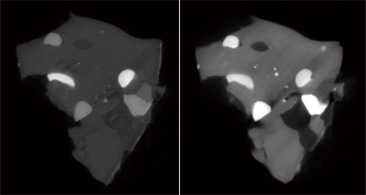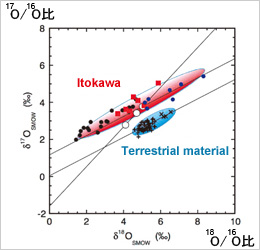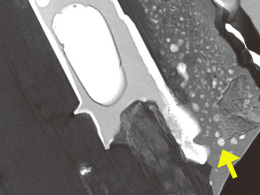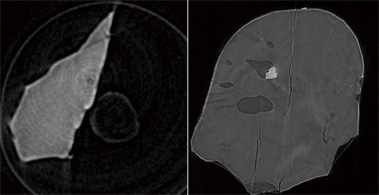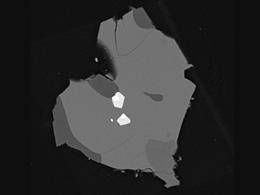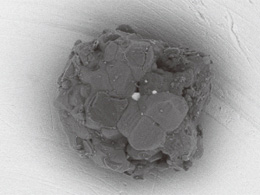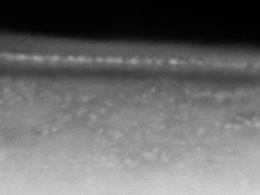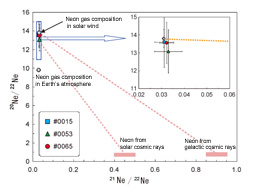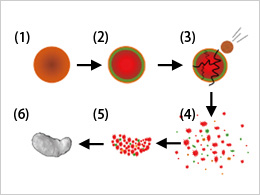We know that 80 percent of meteorites that fall to the Earth are made up of a rocky material called ordinary chondrites (a group of stony meteorite). We also know that Itokawa is an S-type asteroid, based on our analysis of the sunlight it reflect - a property known as solar spectral reflectance. Since ordinary chondrites and S-type asteroids have similar solar spectral reflectance, scientists had hypothesized that these meteorites originate from such asteroids. But since the solar spectral reflectance between the two is not a 100-percent match, they were unable to prove it.
Our initial analysis of dust particles from Itokawa used the following four methods to find out whether the particles have the same composition as ordinary-chondrites.
First, Professor Akira Tsuchiyama and his group at Osaka University used an X-ray micro-CT scanner to map the dust particles' shape and inner structure in three dimensions. They also identified the minerals the particles are made of, and mapped their three-dimensional spatial distribution.
Next, Professor Tomoki Nakamura and his group at Tohoku University used electron microscopes in conjunction with an X-ray diffraction technique to investigate the specific chemical composition of the minerals that make up the dust particles. They learned that the particles are made up of minerals such as olivine, pyroxene, plagioclase, troilite (iron sulfide), taenite (an alloy of iron and nickel) and chromite. This combination of minerals is not found on Earth; it is unique to extraterrestrial ordinary chondrites.
Professor Hisayoshi Yurimoto and his group at Hokkaido University examined the abundance ratio of oxygen atoms of different weight (isotopes). Oxygen, the main element in the composition of planets, has three isotopes of different weights, and each planet has different abundance ratios of each isotope.
Finally, Professor Mitsuru Ebihara and his group at Tokyo Metropolitan University used neutron activation analysis to study the concentration of different elements in the particles. This is a process in which the sample is bombarded with neutrons. By measuring the minute amounts of radiation released when the neutrons strike the sample, scientists can determine the precise amount of each element in the particle.
The studies found that Itokawa has LL-type mineralogy, a type found in the ordinary-chondrite group, because of its oxidation environment, which is one containing an abundance of oxygen trapped inside crystals. This is proof that the ordinary chondrites that frequently strike the Earth come from S-class asteroids.
Using electron microscopes, researchers discovered that the Itokawa particles have broken crystals and white grains, indicating that strong impacts partially melted the rock and produced bubbles. This means that the parent object from which Itokawa originated was subjected to powerful collisions with other astronomical objects.
Also, an X-ray micro-CT analysis confirmed the presence of particles with sharp edges, as well as others with rounded edges. Researchers believe that the sharp edges were caused by angular particles when the original asteroid smashed into another object, and that the rounded edges were caused by oscillations during subsequent collisions with other asteroids. When an asteroid collides with another astronomical object, the material on the asteroid's surface is smashed into smaller pebbles, sand and dust - a material known as regolith. It may be that when Itokawa collides with another asteroid, the impact shakes the whole asteroid in a way that pushes the regolith into relatively flat regions such as Muses Sea. That's where HAYABUSA collected its sample.
Analysis of the chemical composition of the dust particles has found evidence that the inside of the asteroid was once hot - about 800°C. To reach that kind of inner temperature, an asteroid would have to be around 20 kilometers in diameter, so scientists estimate that Itokawa's parent body was once at least that large. They think that heat was generated by the decay of radioactive elements inside the asteroid. Today, Itokawa only about 500 meters across, just 1/40th the diameter of the parent body.
Space is full of high-energy particles (i.e. radiation) from the Sun and from objects outside our solar system. Particles from the Sun are called solar wind, while those from outside the solar system are called galactic cosmic rays, and astronomical objects are constantly bombarded by both types. So an asteroid's rocky surface is altered not just by other objects, but by solar wind and galactic cosmic rays, which turn the asteroid's surface dark, as if it were scorched. This phenomenon is known as "space weathering."
Scientists have believed for some time that the reason spectral-reflection values of meteorites and asteroids do not completely match is that asteroids are subject to space weathering. Now we have discovered direct evidence that this hypothesis is correct.
To investigate space weathering on Itokawa, Professor Takaaki Noguchi and his group at Ibaraki University stabilized the particles by placing them in a resin, and sliced them into ultra-thin cross-sections. They then studied the cross-sections, which are approximately 0.1 µm (0.001 mm) thick, with an electron microscope. The group found bright white spots in an area ranging from the particle's surface down to approximately 50 nm (0.05 µm) inside. They identified these as nanoparticles containing iron, which were created by space weathering. Scientists think that when charged (ionized) particles from solar wind strike the surface at high speed in vacuum, the impact creates nanoparticles mainly composed of metallic iron. These iron-bearing nanoparticles are what causes the varying hues of Itokawa's surface. And a chondrite that has been subjected to space weathering has the same spectrum as an S-type asteroid.
HAYABUSA's Challenge
Asteroids: The Primitive Objects in the Solar System
Using Oxygen to Trace the Origins of Meteorites
Particles from Itokawa: A Treasure for the World

